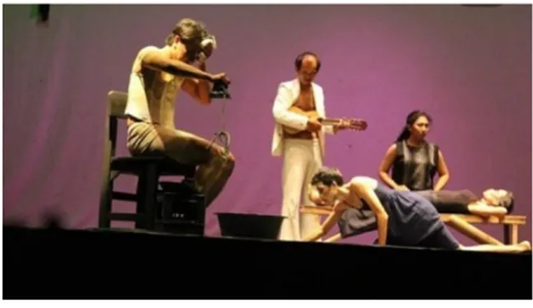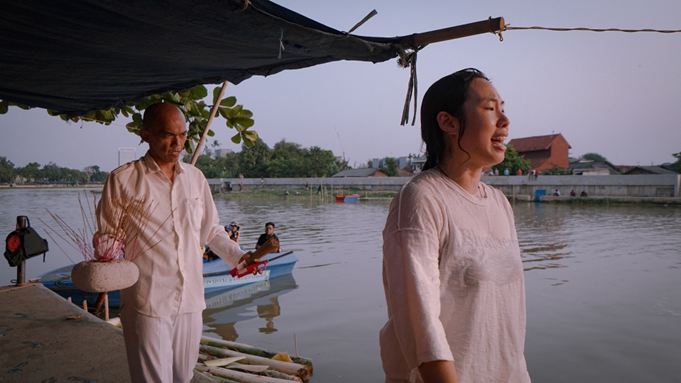PORTFOLIO of Mohammad Dendi Madya Utama a.k.a Dendi Madiya (Theatre Director, Playwright, Performer)
Membuka Kardus Arsip 1942-1945 (Unboxing The Archives 1942-1945)
Collaboration of Artery
Performa, Komunitas Ranggon Sastra, RUTE, Teater Afiks
Co-Director: Abi ML,
Dendi Madiya
Teater
Kecil-Taman Ismail Marzuki-Jakarta, May 8-9, 2018
Video link: https://www.youtube.com/watch?v=iruzppsMhFQ
Sublimating the archives of the
Japanese occupation era and turn on the archives through present day bodies, as
a possible means of discovering the meaning of the archives for today's
Jabodetabek youth.
1.
Graphic
Archive 2. Photo Archive 3. Film Archive 4. Text Archive 5. Song Archive 6.
Object Archive
We sublimed the archives by the way:
1.
montage
graphics & video 2. live performance 3. choreography 4. speech 5. dramatic
reading 6. choir 7. music 8. juxtapose the type and timeline of the archives 9.
voice over text 10. the composition of the object
through chronological dramaturgy and
montage to produce the aesthetics and contemporary meaning of the archive.
(The performance is part of the
program of Archive Theater 2018, organized by Jakarta Arts Council, entitled
"3 ½ Years Worked: Japanese Occupation Art and Propaganda 1942-1945")
Dendi Madiya
(Producer & Director) with Artery Performa
Graha Bhakti Budaya-Taman Ismail
Marzuki-Jakarta, July 8, 2019
Video link: https://www.youtube.com/watch?v=LH6BN6zW6RY&t=3381s
Underscore: Copy Paste Sae is a
reenactment of three performance documentation videos of Teater Sae, namely
Pertumbuhan di Atas Meja Makan (1991), Biografi Yanti Setelah 12 Menit (1992)
and Migrasi dari Ruang Tamu (1993). This theatre-performance copypaste-edited
the core of dramaturgy from those three videos, copypaste-edited what represent
the “performance body” of those three works of Teater Sae.
The video footage selection was
based on my observation on the dramaturgy of Teater Sae that was presented in
those documentation videos. In all three, we can witness the presence of
meditative, slow tempo scenes performed by solemn actors, felt as an effort to
fight or stop the time. Performances of Teater Sae also present many text
quotes from Indonesian political and intellectual figures and abroad. Archives
and data, pieces of pop songs and national songs, quotes from plays, included
in their performances, making them like “theatre of book,” as said by Afrizal
Malna, the author of the three performances.
The three performances directed
by Boedi S. Otong often present hysterical-explosive bodies, as well as the
formation of oratoric-poetic-pressing-suggestive text pronunciation),
especially as shown by their main actors, namely Margesti and Zainal Abidin
Domba. The object composition presented in Teater Sae shows more daily objects
arranged to represent domestic spaces (households) that cannot protect
themselves from outside influences. These everyday objects are also treated
symbolically in the action of involving actors, to represent the Orde Baru’s (New
Order regime) sociopolitical conditions which filled with uniformity, neatness
and repression.
Actors at the Underscore: Copy Paste Sae are trying to copypaste
the play of actors who appeared on performance videos of Teater Sae. Imitation
is endeavored on gesture, tone of text pronunciation, vocal color and tempo of
the performance. The Actors psychological processing is also helped by the
meanings taken from Teater Sae’s scripts. Sound elements such as music and
sound effects are taken from all three videos. The sound parts attached to
actor’s voice is made to replicas. The lighting is set close to what is
contained in video by not setting aside the possibility of technical
interpretations. Underscore: Copy Paste Sae also inserts materiality of those
three videos. Especially the cut parts, blank and scratch, video parts that are
less clear from the text spoken by actor. In addition, video sequence that do
close-shot recording make some actor movements not accurately detected. This project wanted to check: why can the Teater Sae's bodies or
dramaturgy strategies circulate in Indonesian theatre without the younger
Indonesian theatre generation even watching Teater Sae?
The Diary of
Voyager
Collaboration of
Shan-Dong-Ye Troupe, Artery Performa, Semanggi Foundation
Tugu Jam Argotech, Pasar Lama,
Tangerang - Klenteng Boen Tek Bio - Masjid Jami Kalipasir - Tao Pe Kong Air -
Kramat Pe Chun, August 30-31, 2019
Performer & Collaborators: Boy
Mihabalo, Dendi Madiya, Musa Carlos, Fidelis Krus, Ricky Unik (INDONESIA)
Chang, Shih-Fen; Chang, Ting-Wei; Chang, Ting-Yong; Lin, Jin-Yan; Wong,
Yun-Ting (TAIWAN)
Video link: https://www.youtube.com/watch?v=xoQ3BJqu6WA
The Diary of Voyager is a site specific theater
project initiated by three theater and performance art artists from Taiwan,
namely Chang, Ting-Wei; Chang, Ting-Yong and Wake-Up (Liu, Wai-Kai). They were
members of the Shan Dong Ye Troupe. This project based on the Cisadane River,
Tangerang-Banten, Indonesia. The performance itself was taking mobile location
from the Pasar Lama area, Tangerang, then to Boen Tek Bio Temple, Kalipasir
area, TaoPe Kong Air to Kramat Pe Chun.
Rivers are always important sites for a city. The
river shows many contemporary issues in its flow, as a mirror, as a reflection.
This project seeks to look into the conflicts between civilization and nature;
between construction and destruction; between 'floating' and 'moored'; also a
dialogue with the collective memory of the city.
From the Cisadane River, Tangerang, there is history
that is not shared and there is history that is always questioned. Below and
above the river flow, time passes, reflecting fragments of events from the
past, present to future. A classic song from Taiwan reminds the 'living' and
'the dead', also asking, why separate yourself through obstacles? However,
there is a river flowing in our bodies that conveys that the timeline is not
straight, but circular, even breaking and colliding with each other so that it
needs to be bridged or simply left to scatter. As said in a contemporary
Indonesian poem, we are not the center of everything. We have made a house, but
in surprise we ask, where to go home? Look, there are lots of cartons of our
children's milk floating towards the black Cisadane River in Tanjung Burung,
some of which are stuck in the trees.
Collaboration of Bandar Teater Jakarta (Indonesia) & Shan
Dong Ye Troupe (Taiwan)
September 4, 2022
Performers: Informix Enchen, Liswati, Malhamang Zamzam,
Shuhan Shu
Dramaturg: Akbar Yumni
Director: Dendi Madiya
Venue: Shan Dong Ye Troupe Studio, 4F, N0. 372, Zhongzhen
Rd,. Hualien City, Hualien County 970005, Taiwan
Video link: https://youtu.be/5Qd6Gt40GBc
With regards to the issue of COVID 19, there were
big differences between Taiwan and Indonesia. Taiwan has been quite successful
in dealing with COVID 19, while Indonesia was experiencing certain dynamics.
From these differences, the questions that can be raised are whether there are
really areas on earth that are sterile from COVID 19? Why does the hysteria of
COVID 19 tend to be minimal in villages? Is COVID 19 an epidemic for cities in
the world? What is the greatest effect COVID 19 has on cities? What is the
future for post-pandemic cities?
In this project, artists from Taiwan and Indonesia
shared experiences of the pandemic situation recorded in the body and in the
environmental ecosystem of each artist. An exchange of experiences like this
makes it possible to see the changes in which direction the pandemic is moving.
Or, humans are too frozen to change even under a pandemic situation.
Covid-19
has disrupted theater. The public cannot watch the theater live because of the
ban on gathering to prevent the spread of the virus. Many show plans were
cancelled. Liveness as a theatrical language, the main element and
characteristic of theatre, as well as the roots of theater which requires the
audience and spectacle in the unity of space and time were difficult to
realize. While the theater is a joint ceremony.
Not
only this time, the theater as a crowd of bodies was "set in order."
Since a long time ago, when the pandemic hit, this has already happened. It
wasn't until the 20th century that Louis Pasteur studied viruses and bacteria
as the cause of disease. Viruses and bacteria were to blame for the plague, not
the human body itself. However, until this Covid-19, the handling of the
outbreak was still focused on controlling the human body. The method of
disciplining the body is still the same. Viruses that are invisible to the
naked eye make humans seem unable to fight them.
This
performance tap into the theater's view of the pandemic through some plays.
The COVID-19 is still ongoing in
various parts of the world, has produced dramatic archives. Maybe
it is still fresh in our memory when we
watch a short video of
how Wuhan residents beat kitchen utensils from behind the walls of flats to
cheer up one another in the precarious conditions of the pandemic. Dramatic
archives that show struggles, humanist actions, contemplations, tragedies and
the irony of humanity in the midst of a pandemic. These archives are in the
form of videos, photos, sound recordings and writings which are circulating on
social media, mass media and the internet. This
performance processed these
dramatic archives into human dramaturgy in the midst of a pandemic. Where are the
similarities and differences between human hysteria in the face of a pandemic?
According to Antonin Artaud, theater should be like
a plague. Theater must make the audience "infected." This performance transmited the experience of
the pandemic to audiences with diverse backgrounds through the possibility of
mixing elements: conventional
drama,
performance of body movement, audio-visual Installation
and outdoor performance.
Co-Director: Suwarni a.k.a
Adek Ceeguk & Dendi Madiya
Bantargebang Landfill Environment, Bekasi, November 28,
2023
Video link: https://www.youtube.com/watch?v=S7ceAghJtV0
This piece created a performance on a mountain of rubbish as a specific
landscape of Bantargebang, Bekasi, West Java. Not only it is the final dump for
Jakarta and Bekasi, the Bantargebang trash mountain also affects other sites in
the surrounding area which was translated in this performance into a spatial
choreography. "Goyang Bulok" invited the audience to get as close as
possible to the mountains of rubbish to experience a confrontational situation
between super productive waste creators and the giant objects they produced.
Through traveling around, conversations, choreography and sound, this
performance expressed the dynamics of life affected by mountains of rubbish;
starting from history, myth, economics, culture, environment to climate change.







Comments
Post a Comment